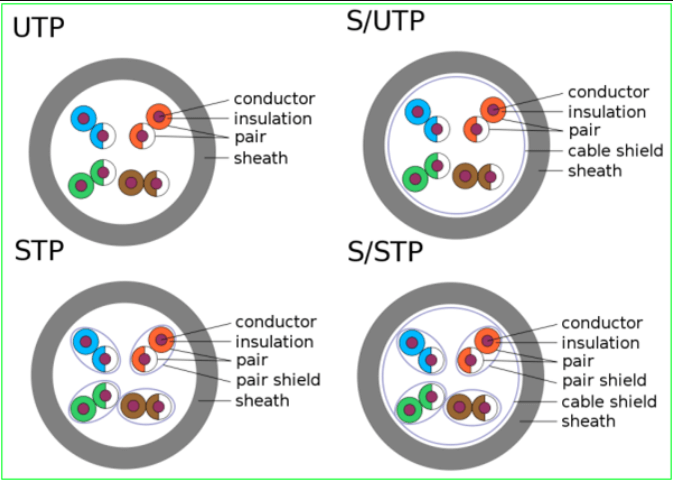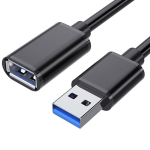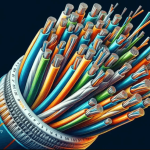In the realm of data transmission, the quest for reliability and efficiency remains paramount. Amidst the technological evolution, one solution has consistently stood out for its prowess in ensuring stable and secure communication: Shielded Twisted Pair (STP) cabling. As industries continue to demand higher speeds, greater bandwidth, and enhanced signal integrity, the significance of STP technology has only grown more pronounced.
At its core, Shielded Twisted Pair represents a triumph of engineering ingenuity, combining the time-tested principles of twisted pair cabling with innovative shielding techniques. This marriage of simplicity and sophistication has revolutionized the way data is transmitted, offering a robust solution capable of withstanding electromagnetic interference (EMI) and external noise, thereby preserving signal integrity even in the most demanding environments.

Construction and Design
STP cables are constructed with pairs of insulated copper wires twisted together in a helical manner. The twisted configuration helps to cancel out electromagnetic interference, resulting in clearer signal transmission. Additionally, a metallic shield surrounds the twisted pairs, further reducing EMI and providing additional protection against external interference.
Advantages of STP
STP cables offer several advantages over unshielded alternatives. Firstly, they provide superior protection against electromagnetic interference, making them ideal for use in environments with high levels of electrical noise. This results in more reliable data transmission and reduced signal degradation over long distances. Furthermore, the shielding in STP cables also enhances security by preventing eavesdropping and unauthorized access to data.
Disadvantages of STP
Despite their numerous benefits, STP cables also come with some drawbacks. One major consideration is cost, as the additional shielding and construction complexity can make STP cables more expensive than unshielded options such as unshielded twisted pair (UTP). Additionally, the installation of STP cables requires careful attention to grounding and shielding techniques, which can increase labor costs and installation time.
Applications of Shielded Twisted Pair
STP cables find applications in various industries and environments where reliable data transmission is critical. They are commonly used in industrial settings where electromagnetic interference is prevalent, such as manufacturing plants and power stations. Additionally, STP cables are also widely used in telecommunications infrastructure and data centers, where high-speed data transmission and security are paramount.

Comparison with Unshielded Twisted Pair (UTP)
While both STP and UTP cables utilize twisted pair configurations, they differ in terms of shielding and performance. STP cables offer superior protection against electromagnetic interference due to their shielding, resulting in higher data transmission rates and fewer errors. On the other hand, UTP cables are more cost-effective and easier to install, making them a popular choice for residential and small-scale applications.
Installation Tips
Proper installation of STP cables is essential to ensure optimal performance and reliability. Grounding techniques play a crucial role in minimizing electromagnetic interference, so it’s important to ensure that the cables are properly grounded according to manufacturer specifications. Additionally, implementing effective cable management strategies can help reduce signal crosstalk and interference, further enhancing the overall performance of the network.
Maintenance and Troubleshooting
Like any other networking infrastructure, STP cables require regular maintenance to ensure continued reliability and performance. Common issues such as cable breaks, connector damage, and signal degradation can occur over time, so it’s important to conduct periodic inspections and testing. Troubleshooting procedures may include cable continuity tests, signal integrity measurements, and visual inspections to identify and rectify any problems.
Future Outlook
The future of STP technology looks promising, with ongoing advancements in materials and design techniques aimed at further improving performance and reducing costs. As the demand for high-speed data transmission continues to grow, STP cables are expected to play an increasingly important role in supporting the infrastructure of tomorrow’s digital networks. Additionally, emerging technologies such as Power over Ethernet (PoE) are driving the development of new STP cable solutions tailored to specific application requirements.
Conclusion
In conclusion, shielded twisted pair (STP) cables offer a robust and reliable solution for high-speed data transmission in challenging environments. With their superior protection against electromagnetic interference and enhanced security features, STP cables are well-suited for a wide range of applications across various industries. While they may come with higher upfront costs and installation complexity, the long-term benefits of STP cables justify their adoption in mission-critical networking infrastructure.
Frequently Asked Questions OnShielded Twisted Pair
1.What is the primary purpose of shielding in STP cables?
The primary purpose of shielding in STP cables is to minimize electromagnetic interference (EMI) and ensure reliable data transmission.
2.How does STP differ from UTP?
STP cables have an additional shielding layer to protect against EMI, whereas UTP cables do not have this shielding, making them more susceptible to interference.
3.Are STP cables suitable for outdoor use?
Yes, STP cables can be used outdoors, but they may require additional weatherproofing measures to protect against moisture and environmental factors.
4.Can STP cables be terminated with standard RJ-45 connectors?
Yes, STP cables can be terminated with standard RJ-45 connectors, although special attention should be paid to ensure proper grounding and shielding.
5.What are the cost implications of choosing STP over UTP?
STP cables tend to be more expensive than UTP cables due to their additional shielding and construction complexity, but they offer superior performance and reliability in demanding environments.








